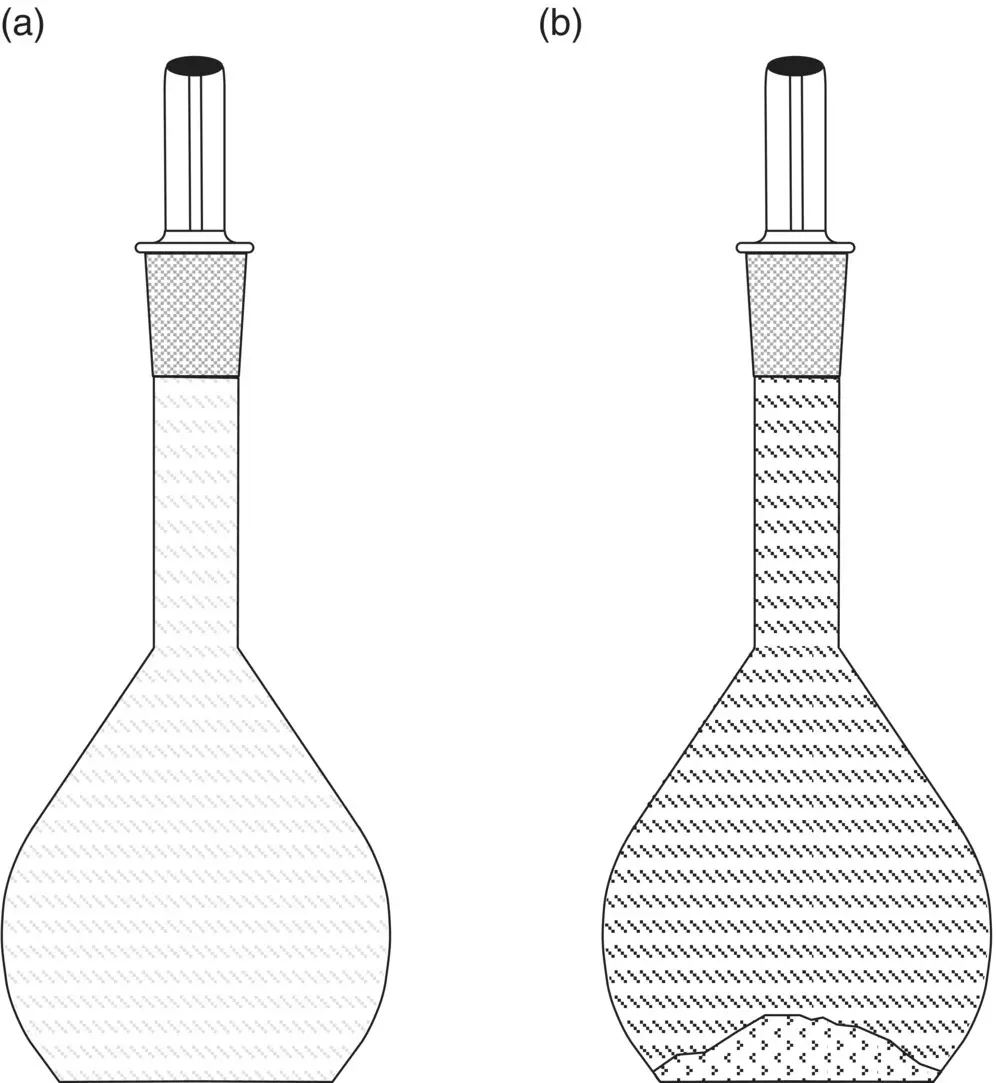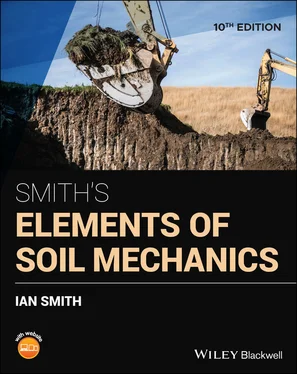1.7.2 Degree of saturation, S r
The voids of a soil may be filled with air or water or both. If only air is present the soil is dry, whereas if only water is present the soil is saturated . When both air and water are present the soil is said to be partially saturated. These three conditions are represented in Fig. 1.12a–c.
The degree of saturation is simply:
(1.9) 
(usually expressed as a percentage)
For a dry soil, S r= 0
For a saturated soil, S r= 1.0
1.7.3 Particle density, ρ sand specific gravity, G s
The specific gravity of a material is the ratio of the weight or mass of a volume of the material to the weight or mass of an equal volume of water. In soil mechanics the most important specific gravity is that of the actual soil grains and is given the symbol G s.
From the above definition it is seen that for a soil sample with volume of solids, V s, mass of solids, M sand weight of solids, W s,
(1.10) 
where ρ wis the density of water (=1.0 Mg/m 3at 20 °C) and γ wis the unit weight of water (=9.81 kN/m 3).
The density of the particles ρ sis defined as:


Fig. 1.12 Water and air contents in a soil. (a) Dry soil. (b) Saturated soil. (c) Partially saturated soil.
therefore,

If ρ sis measured in units of Mg/m 3and the water temperature is assumed to be 20 °C, it follows that ρ sand G sare numerically equal. G s, however is dimensionless whereas ρ shas the units of density, Mg/m 3.
Particle density is determined in the laboratory through a well‐established and reliable testing procedure (described in BS EN ISO 17892‐3:2015, BSI, 2015). A mass of dry soil is mixed with distilled water in a standard glass vessel known as a pycnometer to separate all the particles and to enable all the air to be removed from the soil. In the test the difference in the volumes of water required to fill the pycnometer, both with and without the soil present, is determined. The particle density is equal to the dry mass of the soil divided by that volume difference.
For sands and fine soils, a sample of the soil (minimum 10 g) is oven dried, weighed and placed into the pycnometer of minimum volume 50 ml along with distilled water at room temperature ( Fig. 1.13). Coarse soils can be tested in a larger pycnometer or the gravel portion can be mechanically broken down to pass a 4 mm sieve and placed in the smaller pycnometer. Formerly, in the UK, a 1 l gas jar was used for coarse soils – see earlier editions of this book for details of the gas jar procedure.
The pycnometer and contents are shaken steadily but vigorously to remove all air bubbles. The glass stopper is then removed, the jar topped up carefully to full capacity with further distilled water and the stopper replaced to seal the vessel without trapping any air inside. The stopper has a capillary tube through it, which permits the water to flow out its top as it is inserted into pycnometer. From various weighings that are made, the particle density of the soil can be calculated (see Example 1.7).

Fig. 1.13 Pycnometer used in the determination of particle density. (a) Pycnometer filled with water only. (b) Pycnometer filled with soil and water.
Example 1.7Particle density
The mass of an empty pycnometer, together with its glass stopper, was 178.0 g. When completely filled with water and the stopper fitted the mass was 228.2 g. An oven dried sample of soil was placed in the pycnometer and the total mass, including the stopper, was 191.2 g. Water was added to the soil and, after a suitable period of shaking, was topped up until the vessel was brim full. The stopper was fitted and the total mass was found to be 236.4 g.
Determine the particle density of the soil.
Solution:






The particle density can be quickly found from a formula thus:

where
ms = mass of dry soil (g)
m1 = mass of pycnometer + water (g)
m2 = mass of pycnometer + water + soil (g)
1.7.4 Density and unit weight
The amount of material in a given volume, V, may be expressed in two ways:
the amount of mass, M, in the volume, or the amount of weight, W, in the volume.
If we consider unit volume, the two systems give the mass density and the weight density of the material respectively. The mass density is usually simply referred to as density and the weight density is routinely referred to as the unit weight :
(1.11) 
(1.12) 

As an example, consider water at 20 °C:
Density of water, ρ w= 1000 kg/m 3= 1.0 Mg/m 3
Hence the unit weight of water, γ w= 1.0 × 9.81 = 9.81 kN/m 3.
Soil densities are usually expressed in Mg/m 3to the nearest 0.01.
Читать дальше




























